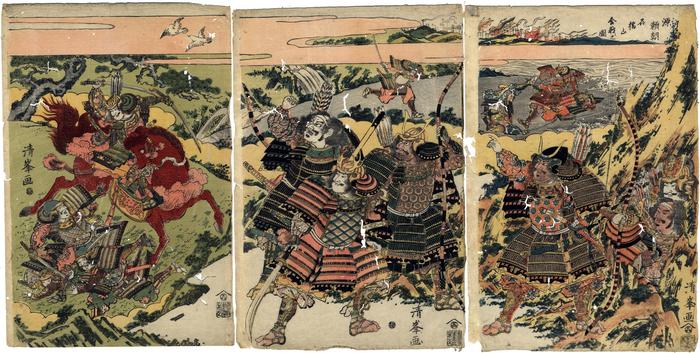Torii Kiyomine (鳥居清峯) (artist 1787 – 1868)
Warrior (musha-e) triptych of Minamoto no Yoritomo at the Battle of Ishibashiyama (源頼朝石橋山合戦之図)
1810s
30 in x 15 in (Overall dimensions) Japanese color woodblock print
Signed: Kiyomine ga
清峯画
Publisher: Nishimuraya Yohachi
(Marks 391 - seal 23-016)
Censor's seal: kiwame
Musées Royaux d'Art et d'Histoire (via Ritsumeikan University) - the right-hand panel only The Battle of Ishibashiyama: significance, myth and its aftermath
The battle at Ishibashiyama in 1180 was one of the first events of the Genpei War. Minamoto no Yoritomo had rebelled against the Taira clan, which was the dominant force at that time. Yoritomo lost this battle and fled into the hills. Desperate for a hiding place, he and his men sheltered inside of an old tree. One of his pursuers, Kajiwara Kagetoki (ca. 1162-1200), spotted Yoritomo in the hollow of the tree, but, for whatever reason, told his cohorts that all he had seen there were a bunch of old spiders. Kagetoki then pointed out the two birds flying away from the tree, in some kind of proof that the enemy could not be hidden there. It worked.
Yoritomo survived, ended up victorious and became Japan's first shogun.
****
William Deal in his Handbook to Life in Medieval and Early Modern Japan wrote on page 54: "Minamoto no Yoritomo (1147–1199) Ruled 1192–99 as first Kamakura shogun. Yoritomo came to prominence as the commander of the Minamoto troops that defeated the powerful Taira family in the Gempei War (1180–85). With the victory, Yoritomo established the Kamakura shogunate, thereby inaugurating warrior rule of Japan that lasted until 1868. Yoritomo’s warrior government was headquartered in the city of Kamakura, and in 1192 Yoritomo was named shogun by the emperor. Yoritomo established a number of governmental offices including the samurai-dokoro, the kumonjo, and the monchujo to oversee governance of Japan. He ruled as shogun for seven years before dying of injuries sustained during a horse-riding accident in 1199."
****
Although there are no identifying cartouches naming the characters represented in this triptych we believe we can possible name two of them. One is one of the figures along the right-hand side of the right sheet. This is the one with the whiter looking face. He is wearing a helmet decorated with a front facing dragon. The same style of helmet worn by both Yoritomo and his younger brother Yoshitsune.
****
As of now, this is the only musha-e triptych that we have been able to find among Kiyomine's works. Most of them deal more with bijin-ga.
Nishimuraya Yohachi (西村屋与八) (publisher)
warrior prints (musha-e - 武者絵) (genre)
